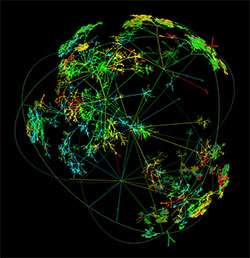SDSC Image of the Internet Universe on Display at New York’s Museum of Modern Art

A visualization depicting a frozen moment of activity in the Internet universe using computer tools at the San Diego Supercomputer Center at the University of California, San Diego, will be part of a special exhibit set to open later this month at the Museum of Modern Art in New York.
The MOMA exhibit, called Design and the Elastic Mind, highlights the dramatic changes we have been experiencing as a society in what once were some of the most established dimensions of human life: time, space, matter, and individuality. The showing focuses on examples of successful translations of “disruptive innovation,” as well as reflections on the future responsibilities of design.
Of particular interest is the exploration of the relationship between design and science, particularly the approach to scale. One such area is the ever-changing dynamics of the Internet, which along with the vast abundance of digital data has revolutionized how we access and share information while at the same time stretching our minds to adapt to and embrace these changes.
The SDSC image was created by Young Hyun and Bradley Huffaker, researchers with the supercomputer center’s Cooperative Association for Internet Data Analysis (CAIDA) program. CAIDA, co-founded in 1998 by kc claffy, an SDSC director and principal investigator, is an independent research group dedicated to investigating both the practical and theoretical aspects of the Internet. While CAIDA has been exploring myriad issues associated with the Internet - from routing and topology to security and privacy issues - the program has primarily been focusing on understanding how the Internet is evolving, and developing a state-of-the-art infrastructure for data measurement that can be shared with the entire research community.
The SDSC image on display at the MOMA depicts round-trip times of data packets sent from a web site in Herndon, Virginia, to hundreds of thousand of nodes on the Internet and back again. It was generated using a visualization tool created by Hyun called ‘Walrus,’ which enables researchers to view large data sets using 3-D “hyperbolic geometry” – a form of image distortion resembling a view through a fish-eye lens. This allows users to examine a smaller area while always having the whole graph, rendered inside a sphere, available as a frame of reference.
“Our dependence on the Internet as a vital part of our lives has grown much faster than our ability to understand its underlying structure, performance limits, and overall dynamics,” said claffy. “The Internet’s constant evolution and expansion is fascinating, while at the same time making it perpetually challenging to research, quantify, and analyze.”
Design and the Elastic Mind opens February 24 and runs until May 12, 2008 in the International Council of The Museum of Modern Art Exhibition Gallery on the sixth floor.
Both government and industry participate in SDSC’s CAIDA program. Most of CAIDA's support is currently provided by government agencies such as the National Science Foundation (NSF) and the Department of Homeland Security (DHS).
Source: UCSD





















